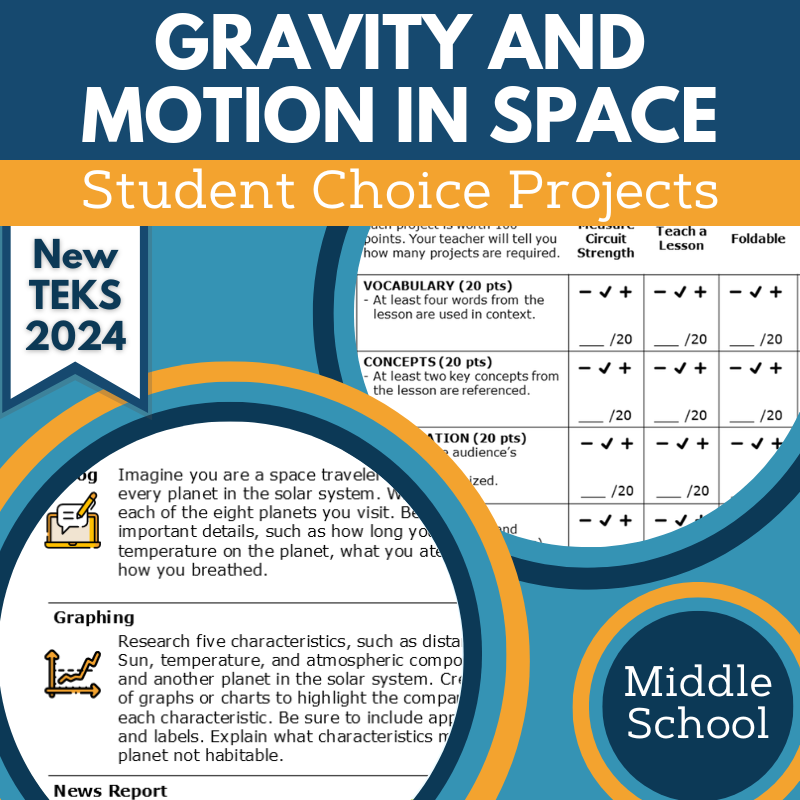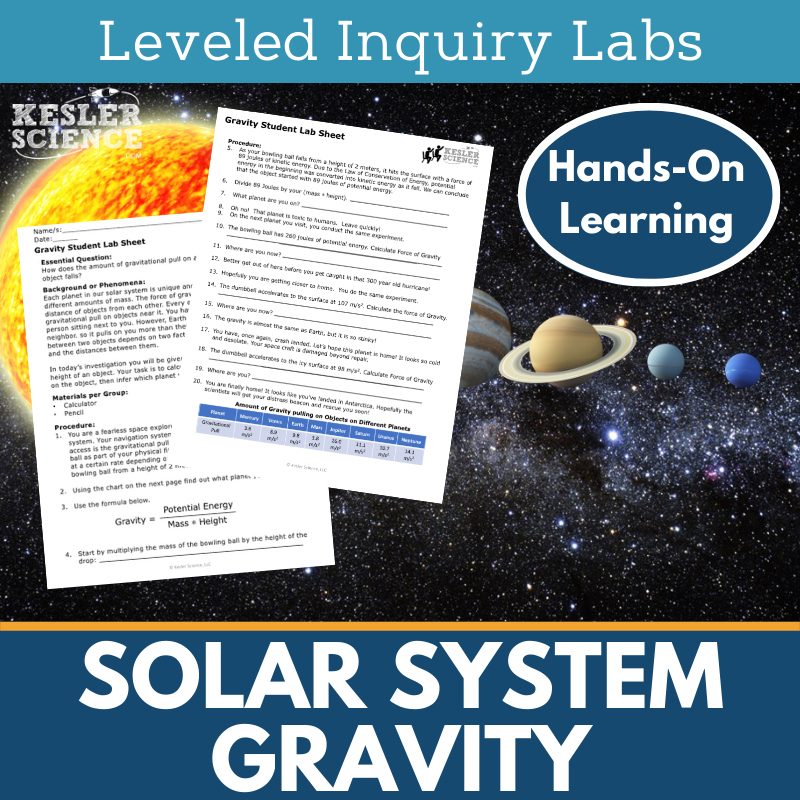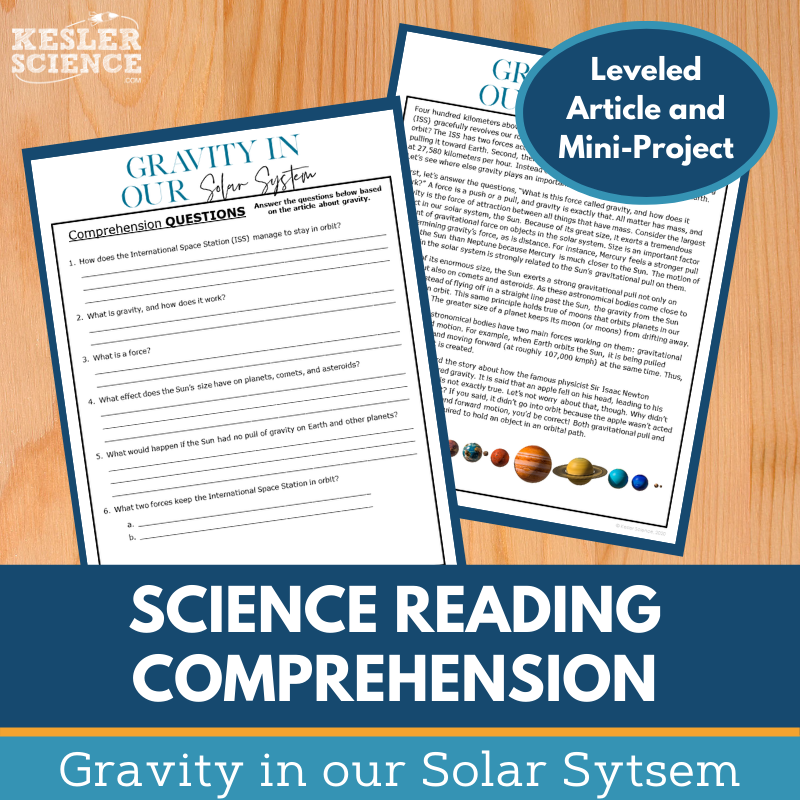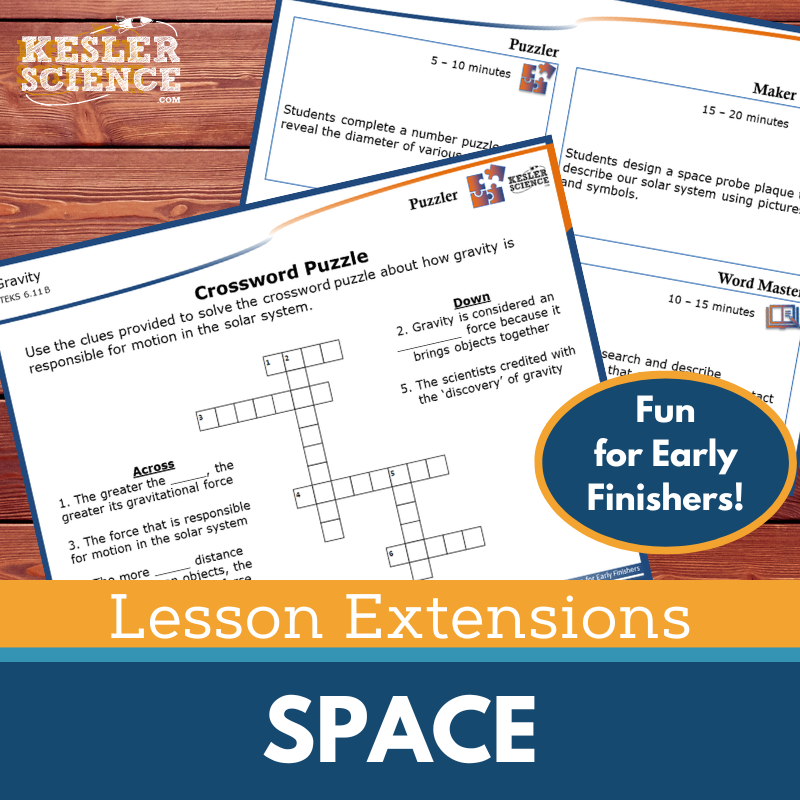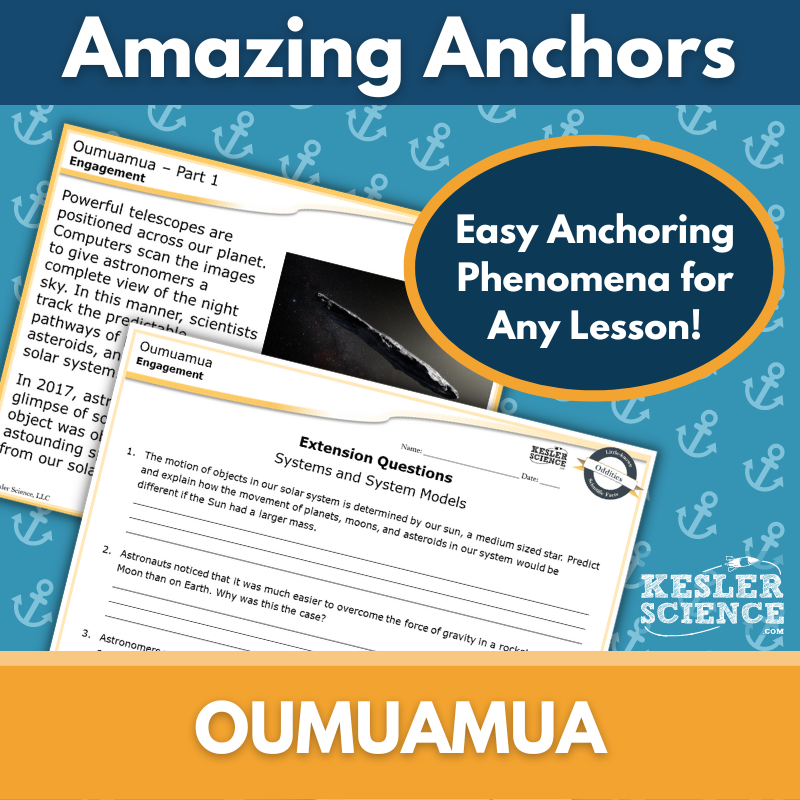Gravity & Motion in Space Activities for Middle School Science
Explore how gravity shapes motion in the solar system with this engaging 5E lesson designed for middle school students. The resources below will give students a comprehensive understanding of gravity and motion in space. All of the following materials are also included in the Kesler Science Membership.
The Kesler Science Gravity and Motion 5E Lesson is a comprehensive space science unit designed for middle school students to explore how gravity governs motion in Earth’s solar system. This fully editable, low-prep lesson includes presentations, worksheets, choice projects, and assessments, all aligned with the 2021 TEKS 7.9B standard.
Following the 5E Model, the lesson begins with engagement activities, including word wall cards and class discussions. The exploration phase features a differentiated, student-led station lab with nine stations, offering hands-on demos, reading passages in English and Spanish, video-based learning, and interactive tasks. Students demonstrate understanding through categorization, writing, illustration, and assessments, with an optional challenge station for enrichment.
The explanation phase includes editable PowerPoints, interactive notebook templates, and note-taking guides. For elaboration, student-choice projects reinforce learning, while evaluation includes STAAR 2.0-aligned assessments and review worksheets. Designed for flexible learning, the lesson is suitable for both in-class and virtual environments, with digital and print options available.
The Kesler Science Gravity and Motion 5E Lesson is a comprehensive space science unit designed for middle school students to explore how gravity governs motion in Earth’s solar system. This fully editable, low-prep lesson includes presentations, worksheets, choice projects, and assessments, all aligned with the 2021 TEKS 7.9B standard.
Following the 5E Model, the lesson begins with engagement activities, including word wall cards and class discussions. The exploration phase features a differentiated, student-led station lab with nine stations, offering hands-on demos, reading passages in English and Spanish, video-based learning, and interactive tasks. Students demonstrate understanding through categorization, writing, illustration, and assessments, with an optional challenge station for enrichment.
The explanation phase includes editable PowerPoints, interactive notebook templates, and note-taking guides. For elaboration, student-choice projects reinforce learning, while evaluation includes STAAR 2.0-aligned assessments and review worksheets. Designed for flexible learning, the lesson is suitable for both in-class and virtual environments, with digital and print options available.
Engage your middle school students with this student-led station lab aligned with TEKS 7.9B, exploring how gravity governs motion within Earth's solar system. Designed for in-class or virtual learning, this interactive Earth science lesson encourages independent and small-group work through nine differentiated stations.
Students encounter new concepts through hands-on exploration, videos, readings, and research activities. They demonstrate learning by organizing information, illustrating models, writing responses, and completing assessments. A bonus challenge station provides extension activities for advanced learners. English and Spanish reading passages support differentiated instruction.
This low-prep, high-engagement resource fosters active learning and critical thinking.
Engage your middle school students with this student-led station lab aligned with TEKS 7.9B, exploring how gravity governs motion within Earth's solar system. Designed for in-class or virtual learning, this interactive Earth science lesson encourages independent and small-group work through nine differentiated stations.
Students encounter new concepts through hands-on exploration, videos, readings, and research activities. They demonstrate learning by organizing information, illustrating models, writing responses, and completing assessments. A bonus challenge station provides extension activities for advanced learners. English and Spanish reading passages support differentiated instruction.
This low-prep, high-engagement resource fosters active learning and critical thinking.
This Gravity & Motion in Space Student Choice Projects align with the 2021 TEKS standard 7.9B, giving middle school students the opportunity to select a project that matches their preferred output style. A project page outlines six student-led options plus a “design your own” project, all with an editable rubric for teacher, peer, or self-assessment. This resource is also part of the Gravity & Motion in Space Complete Lesson for TEKS 7.9B.
These flexible, multimodal projects provide creative ways for students to demonstrate their understanding. Two versions of the project page support differentiation, with modified options for students needing remediation and challenge options for advanced learners. Teachers can adjust the rubric to fit grading needs.
The projects require standard classroom supplies like paper, markers, and scissors, and many options can be completed digitally.
This Gravity & Motion in Space Student Choice Projects align with the 2021 TEKS standard 7.9B, giving middle school students the opportunity to select a project that matches their preferred output style. A project page outlines six student-led options plus a “design your own” project, all with an editable rubric for teacher, peer, or self-assessment. This resource is also part of the Gravity & Motion in Space Complete Lesson for TEKS 7.9B.
These flexible, multimodal projects provide creative ways for students to demonstrate their understanding. Two versions of the project page support differentiation, with modified options for students needing remediation and challenge options for advanced learners. Teachers can adjust the rubric to fit grading needs.
The projects require standard classroom supplies like paper, markers, and scissors, and many options can be completed digitally.
The Gravity and Inertia Inquiry Lab aligns with TEKS, helping students understand how gravity governs the motion of our solar system. Students will model the effects of inertia and gravity on a planet’s orbit and explore the impact of a hypothetical large planet at the solar system’s edge.
This resource includes three differentiated lab versions to support diverse learning needs. The Dependent Lab provides guided inquiry with procedural instructions, the Modified Lab offers a structured approach with sentence stems and multiple-choice questions, and the Independent Lab encourages student-driven exploration with minimal guidance. Reflection questions using Claim, Evidence, and Reasoning (CER) are included to deepen understanding.
Teacher resource pages, editable materials, and answer keys simplify planning. The lab requires common materials such as marbles, a heavier ball, and a fabric sheet. This engaging hands-on activity reinforces gravity’s role in planetary motion.
The Gravity and Inertia Inquiry Lab aligns with TEKS, helping students understand how gravity governs the motion of our solar system. Students will model the effects of inertia and gravity on a planet’s orbit and explore the impact of a hypothetical large planet at the solar system’s edge.
This resource includes three differentiated lab versions to support diverse learning needs. The Dependent Lab provides guided inquiry with procedural instructions, the Modified Lab offers a structured approach with sentence stems and multiple-choice questions, and the Independent Lab encourages student-driven exploration with minimal guidance. Reflection questions using Claim, Evidence, and Reasoning (CER) are included to deepen understanding.
Teacher resource pages, editable materials, and answer keys simplify planning. The lab requires common materials such as marbles, a heavier ball, and a fabric sheet. This engaging hands-on activity reinforces gravity’s role in planetary motion.
This Gravity Science Reading Comprehension Lesson helps students explore the force that governs motion in our solar system through a nonfiction article, comprehension questions, and a hands-on straw rocket activity. Designed for grades 6-8 (and advanced 5th graders), the leveled passage supports science literacy and reading comprehension.
The resource includes two Lexile-leveled articles (1100-1300), five to seven comprehension questions, a hands-on mini-project, and a Cornell notes template. Engaging graphics are provided and can be printed in grayscale.
This resource is suitable for in-person and virtual learning, compatible with Google Classroom, MS Teams, Schoology, and Canvas. Students can complete assignments directly in a PPT or Google Slides format.
Ideal for sub plans, extra credit, ISS, or whole-class instruction, this resource fosters critical thinking, classroom discussions, and textual analysis while reinforcing key gravity concepts.
The Gravity Science Reading Comprehension Lesson helps students explore the force that governs motion in our solar system through a nonfiction article, comprehension questions, and a hands-on straw rocket activity. Designed for grades 6-8 (and advanced 5th graders), the leveled passage supports science literacy and reading comprehension.
The resource includes two Lexile-leveled articles (1100-1300), five to seven comprehension questions, a hands-on mini-project, and a Cornell notes template. Engaging graphics are provided and can be printed in grayscale.
This resource is suitable for in-person and virtual learning, compatible with Google Classroom, MS Teams, Schoology, and Canvas. Students can complete assignments directly in a PPT or Google Slides format.
Ideal for sub plans, extra credit, ISS, or whole-class instruction, this resource fosters critical thinking, classroom discussions, and textual analysis while reinforcing key gravity concepts.
The Gravity and Planetary Motion Science Writing Prompt Activity engages middle school students in a skit-based writing exercise to reinforce their understanding of how gravity governs planetary motion. Aligned with TEKS, this student-centered activity enhances science reasoning and exploration while supporting both in-person and virtual learning.
This resource includes teacher directions with an answer guide, project ideas, and rubrics, along with projection and print handouts in both full-sized and half-sheet formats. A digital interactive version is also available in PowerPoint, easily adaptable for Google Slides. The activity works well as a cross-curricular exercise, pre-test assessment, student choice project, enrichment for early finishers, extra credit, make-up work, or differentiation. It also serves as a TELPAS writing sample. Ideal for interactive notebooks or bulletin board displays, this engaging prompt fosters creativity and science literacy in any classroom.
The Gravity and Planetary Motion Science Writing Prompt Activity engages middle school students in a skit-based writing exercise to reinforce their understanding of how gravity governs planetary motion. Aligned with TEKS, this student-centered activity enhances science reasoning and exploration while supporting both in-person and virtual learning.
This resource includes teacher directions with an answer guide, project ideas, and rubrics, along with projection and print handouts in both full-sized and half-sheet formats. A digital interactive version is also available in PowerPoint, easily adaptable for Google Slides. The activity works well as a cross-curricular exercise, pre-test assessment, student choice project, enrichment for early finishers, extra credit, make-up work, or differentiation. It also serves as a TELPAS writing sample. Ideal for interactive notebooks or bulletin board displays, this engaging prompt fosters creativity and science literacy in any classroom.
The WIKI Tickets© Space Set provides engaging formative assessments for 6th-8th grade science, offering flexible ways to check student understanding. This set includes 14 topics, each available in five formats: a full-screen projection version, three printable handout sizes, and a digital interactive version compatible with PowerPoint and Google Slides.
Aligned with NGSS and TEKS standards, these assessments cover key space science topics such as the lunar cycle, space exploration, the H-R diagram, solar system gravity, and the electromagnetic spectrum. Each set includes a table of contents file for standard alignment reference.
WIKI Tickets© can be used as exit tickets, bellringers, or quick checks in both in-person and virtual learning environments. Students can respond on paper, through printed handouts, or digitally in a 1:1 or remote setting. These colorful and engaging assessments help you gauge student understanding with ease.
The WIKI Tickets© Space Set provides engaging formative assessments for 6th-8th grade science, offering flexible ways to check student understanding. This set includes 14 topics, each available in five formats: a full-screen projection version, three printable handout sizes, and a digital interactive version compatible with PowerPoint and Google Slides.
Aligned with NGSS and TEKS standards, these assessments cover key space science topics such as the lunar cycle, space exploration, the H-R diagram, solar system gravity, and the electromagnetic spectrum. Each set includes a table of contents file for standard alignment reference.
WIKI Tickets© can be used as exit tickets, bellringers, or quick checks in both in-person and virtual learning environments. Students can respond on paper, through printed handouts, or digitally in a 1:1 or remote setting. These colorful and engaging assessments help you gauge student understanding with ease.
Lesson Extensions provide engaging, student-choice activities designed to challenge early finishers and deepen their understanding of space science standards. These activities help fill downtime, reinforce critical thinking, and keep students engaged with rigorous yet enjoyable learning opportunities.
Each extension includes four interactive components: Puzzler for problem-solving, Maker Space for hands-on STEAM activities, Tech Connection for digital demonstrations, and Word Master for creative writing. With teacher directions, answer keys, and both print and projection versions, these extensions are perfect for lesson wrap-ups, enrichment, or independent challenges.
Covering topics such as the components of the universe, lunar cycles, space travel, and gravity, these extensions align with NGSS and TEKS standards, ensuring students explore key space science concepts in meaningful and engaging ways.
Lesson Extensions provide engaging, student-choice activities designed to challenge early finishers and deepen their understanding of space science standards. These activities help fill downtime, reinforce critical thinking, and keep students engaged with rigorous yet enjoyable learning opportunities.
Each extension includes four interactive components: Puzzler for problem-solving, Maker Space for hands-on STEAM activities, Tech Connection for digital demonstrations, and Word Master for creative writing. With teacher directions, answer keys, and both print and projection versions, these extensions are perfect for lesson wrap-ups, enrichment, or independent challenges.
Covering topics such as the components of the universe, lunar cycles, space travel, and gravity, these extensions align with NGSS and TEKS standards, ensuring students explore key space science concepts in meaningful and engaging ways.
This Amazing Anchors Phenomenon Lesson introduces and reinforces the motion of objects in the solar system through the real-world example of Oumuamua, a mysterious space object. It includes an introductory reading with comprehension and extension questions to prepare students for further learning, followed by an explanatory reading that breaks down the science behind motion in the solar system with additional reinforcement questions.
Aligned with TEKS and NGSS, this no-prep resource includes teacher directions, answer keys, and additional resources. It is available in both print and digital formats for Google Classroom and other LMS platforms, with projection slides and interactive notebook-friendly handouts. A differentiated version provides sentence starters for student support. Designed to bookend a lesson, these engaging readings serve as valuable supplements to reinforce learning in any classroom setting.
This Amazing Anchors Phenomenon Lesson introduces and reinforces the motion of objects in the solar system through the real-world example of Oumuamua, a mysterious space object. It includes an introductory reading with comprehension and extension questions to prepare students for further learning, followed by an explanatory reading that breaks down the science behind motion in the solar system with additional reinforcement questions.
Aligned with TEKS and NGSS, this no-prep resource includes teacher directions, answer keys, and additional resources. It is available in both print and digital formats for Google Classroom and other LMS platforms, with projection slides and interactive notebook-friendly handouts. A differentiated version provides sentence starters for student support. Designed to bookend a lesson, these engaging readings serve as valuable supplements to reinforce learning in any classroom setting.
Year-Round Resources
These year-round activities will increase your students' understanding of many middle school science topics. All of these activities are also included in the Kesler Science Membership.
Visual Data & Graphing
You're not alone if your students struggle with understanding graphs, charts, and tables. It's a skill that takes an enormous amount of practice. This resource will help students build a strong foundation in analyzing data and creating their own data visualizations.
Bell Ringers and Warm-Ups
These middle school science bell ringers are an excellent way to engage your students as soon as they walk into your classroom. This comprehensive FULL YEAR resource includes everything you need to start off each science class with an interesting warm-up activity.
Review Board Games
Each game board has been carefully designed to keep students engaged. There are 10 different action spaces on each board and dozens of question cards. All of the actions are related to science concepts and keep the students motivated throughout the game.
Each game is ready to play. Simply print out the board and the cards and let the students enjoy reviewing nine different units.
Essential Questions and Standards
Below are the essential questions and standards associated with the lessons and activities included in the atoms unit. This topic is only one of more than 100 middle school science topics included in the Kesler Science Membership.
-
How does gravity govern motion within Earth’s solar system?
-
TEKS Science - 7.9B Gravity & Motion in Space
Kesler Science Membership
Imagine never having to search for another middle school science lesson again. The membership gives you access to ALL of the Kesler Science products in one place (Yes, including everything above).
Say goodbye to long hours of lesson prep.





